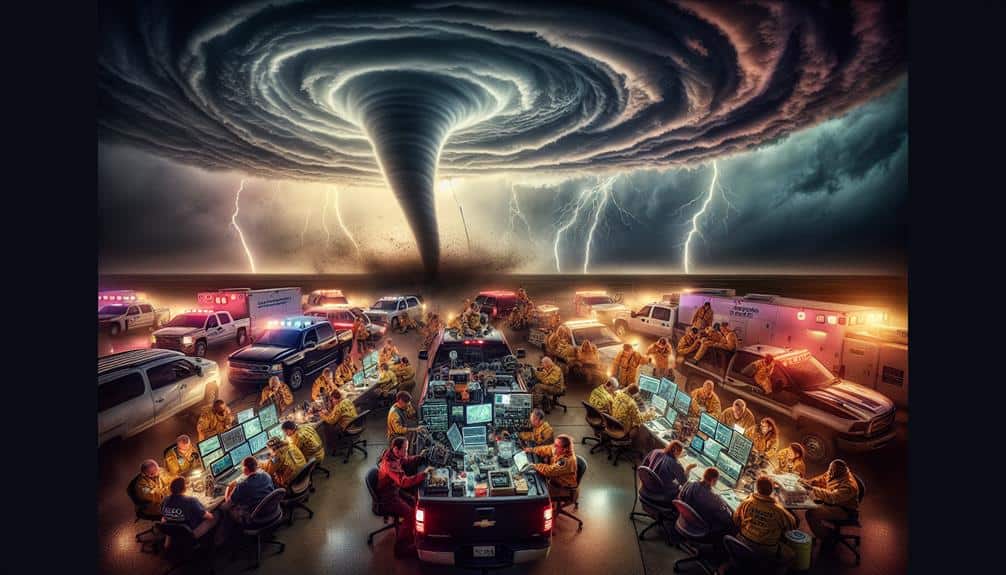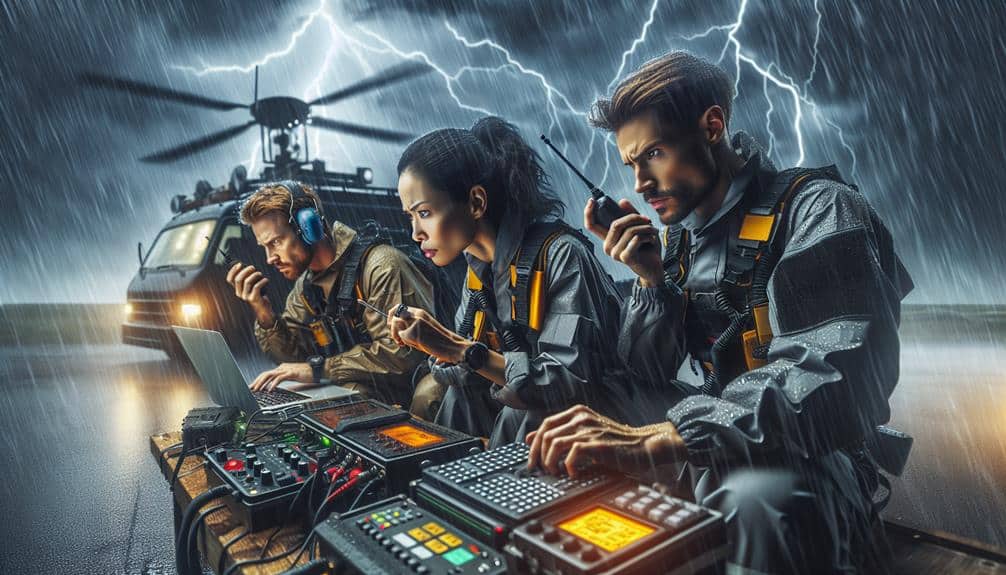We leverage data analytics to greatly enhance emergency coordination. By predicting storm patterns using big data and machine learning, we create precise models to inform response strategies. We guarantee best resource allocation by pinpointing urgent needs and deploying supplies efficiently. Real-time communication is strengthened through data visualization tools, transforming data into intuitive formats. Robust risk assessments allow us to prioritize and customize our actions, while post-event analysis uncovers insights on response effectiveness. Each of these components is vital to a seamless and effective emergency response, with more details unraveling as we explore further.
Key Points
- Data analytics enables real-time resource allocation by identifying urgent needs and potential hotspots in disaster zones.
- Predictive models in data analytics enhance storm pattern forecasting, improving emergency response strategies.
- Advanced data visualization tools transform raw data into intuitive graphs and maps, aiding in real-time communication and decision-making.
- Robust risk assessment methodologies use data analytics to create precise vulnerability maps and tailor disaster response strategies.
Predicting Storm Patterns
By leveraging advanced data analytics, we can accurately predict storm patterns and enhance emergency response strategies. Weather forecasting has evolved significantly with the integration of big data and machine learning. We now have the capability to analyze vast amounts of meteorological data in real time, including temperature, humidity, wind speeds, and historical storm paths. This allows us to create highly accurate predictive models.
These models aren't just theoretical; they've practical, life-saving applications. For example, by predicting the trajectory and intensity of a storm days in advance, emergency response teams can be better prepared. Early warnings provide communities with the time they need to evacuate or secure their properties.
Moreover, precise storm predictions enable us to allocate resources more effectively, ensuring that emergency personnel and supplies are where they're most needed. This kind of preparedness minimizes chaos and maximizes safety.
In essence, our ability to accurately forecast weather conditions through data analytics is a game-changer. It not only enhances our emergency response but also empowers us to make decisions that protect lives and property. Freedom from the unpredictable nature of storms is within our grasp, thanks to these technological advancements.
Resource Allocation
Effective resource allocation is crucial for ensuring timely and sufficient emergency response during disasters. Data analytics allows us to achieve optimal distribution and efficient utilization of resources, tailoring our efforts to meet the specific needs of affected areas.
By analyzing historical data and real-time information, we can pinpoint where supplies, medical aid, and personnel are needed most urgently.
In emergencies, every second counts. Strategic planning powered by data analytics helps us deploy resources swiftly and wisely. For instance, predictive models can highlight potential hotspots in disaster zones, enabling us to pre-position assets like food, water, and medical kits. This not only speeds up the response but also minimizes wastage and redundancy.
Furthermore, data-driven insights facilitate the reallocation of resources as situations evolve. If a certain area is overstocked while another faces a shortage, analytics can guide us in redistributing supplies seamlessly. This ensures that our emergency response remains dynamic and adaptable, maximizing the impact of every resource deployed.
Real-Time Communication
How can we guarantee smooth real-time communication to coordinate emergency responses efficiently? The key lies in leveraging advanced data analytics and data visualization tools. When we integrate these technologies, we can make certain that all stakeholders have instant access to critical information, enhancing decision-making speed and accuracy during an emergency response.
First, we need robust communication platforms that support real-time data sharing. These platforms should be capable of integrating with various data sources, compiling information in a centralized, accessible format. This enables emergency teams to visualize data trends and monitor evolving situations, allowing for immediate and informed actions.
Next, data visualization plays a pivotal role. By transforming raw data into intuitive graphs, maps, and dashboards, we break down complex information into comprehensible visuals. This not only aids in quick comprehension but also guarantees that everyone involved—from field operatives to command centers—stays on the same page.
Additionally, ensuring data accuracy and reliability is essential. Real-time updates minimize misinformation and reduce response times. As we embrace these technologies, we empower ourselves to act swiftly and effectively, safeguarding communities and enhancing public safety without sacrificing our freedom of action.
Risk Assessment
To effectively coordinate emergency responses, we must prioritize robust risk assessment methodologies that leverage data analytics. Analyzing data allows us to create precise vulnerability mapping, highlighting areas most susceptible to disasters. By identifying these high-risk zones, we can tailor our disaster response strategies more effectively, guaranteeing resources are allocated where they're needed most.
Impact assessment is another critical component. By evaluating potential consequences of various disaster scenarios, we can better prepare for the aftermath. Data analytics enables us to simulate different emergencies, providing insights into probable impacts on infrastructure, populations, and services. This information is crucial for emergency preparedness, allowing us to design more resilient systems and mitigate potential damages.
Moreover, data analytics helps us recognize patterns and trends that mightn't be immediately apparent. For instance, historical data on weather events, seismic activity, or disease outbreaks can inform our risk assessments, enhancing our preparedness for future incidents. This proactive approach ensures we're not just reacting to emergencies, but strategically planning for them.
Post-Event Analysis

Leveraging data analytics in post-event analysis lets us scrutinize the effectiveness of our emergency response and uncover areas for improvement. By diving into detailed data, we can pinpoint what worked well and what didn't, ensuring we're better prepared for future crises.
Analyzing response time is vital. It allows us to see how swiftly we reacted and identify any delays or bottlenecks that hampered our efforts. We can also gauge the adequacy of resources deployed and the coordination between different teams. Data analytics aids in compiling these insights efficiently, transforming raw data into actionable lessons learned.
Here are key aspects we examine in post-event analysis:
- Response time: Measuring how quickly we mobilized and responded.
- Resource utilization: Evaluating if we had the right amount and type of resources.
- Communication efficiency: Assessing the clarity and speed of information shared.
- Coordination: Scrutinizing how well different units worked together.
Frequently Asked Questions
How Can Data Analytics Improve the Efficiency of Emergency Response Teams?
Did you know real-time insights can boost response times by 30%? By leveraging predictive modeling, we can allocate resources more efficiently, anticipate crises, and streamline operations, ensuring our emergency response teams act swiftly and effectively.
What Are the Ethical Considerations in Using Data Analytics for Emergency Coordination?
When using data analytics for emergency coordination, we must address privacy concerns and detect bias. Protecting individual freedoms and maintaining data integrity are essential to avoid misuse and guarantee fair, effective decision-making during crises.
How Does Data Analytics Enhance Public Awareness and Preparedness for Emergencies?
We get it, data can seem overwhelming, but it actually boosts public engagement and preparedness by providing accurate risk assessments. This empowers us to make informed decisions, ensuring our communities stay safe and resilient during emergencies.
What Types of Data Sources Are Most Valuable for Emergency Coordination?
For emergency coordination, we find satellite imagery and social media trends most valuable. Satellite imagery offers real-time visuals of affected areas, while social media trends provide immediate, crowd-sourced information. Both enhance our decision-making and response strategies.
How Can Small Communities Leverage Data Analytics for Better Emergency Management?
We can leverage data analytics by enhancing community engagement and optimizing resource allocation. By analyzing local data, we'll identify critical needs swiftly, ensuring effective responses and empowering our community to manage emergencies more autonomously.


